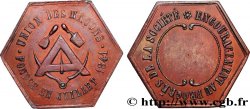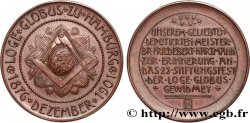fjt_017168 - FRANC-MAÇONNERIE - PARIS PICARDIE - LOGE DE LA PHILANTROPIE - SAINT QUENTIN, refrappe ? 1799
Nicht verfügbar.
Artikel auf unserem Online-Shop verkauft (2013)
Preis : 100.00 €
Artikel auf unserem Online-Shop verkauft (2013)
Preis : 100.00 €
Type : PICARDIE - LOGE DE LA PHILANTROPIE - SAINT QUENTIN, refrappe ?
Datum: 1799
Metall : Kupfer
Durchmesser : 29 mm
Stempelstellung : 12 h.
Rand cannelée
N° im Nachschlagewerk :
Vorderseite
Titulatur der Vorderseite CARRÉ LONG DE. LA. PHILANTROPIE A LO.:. DE. ST. .:. QUENTIN. 5799.
Beschreibung Vorderseite Un frère en tablier debout prête serment devant un autel (ou un sarcophage, celui de Hiram ?) avec un acacia placé derrière, le tout au milieu d'un cercle entouré d'étoiles..
Rückseite
Titulatur der Rückseite ETERNITE CONSTANCE.
Beschreibung Rückseite Une ruche avec son essaim, accostée d'instruments maçonniques, au milieu d'un cercle formé par un serpent Ourobouros.
Kommentare
La conjonction d’un état exceptionnel et d’une frappe en médaille fait craindre la refrappe bien qu’il n’y ait pas d’autre indice. La cannelure de la tranche est normale et se retrouve aussi sur les exemplaires de conservation médiocre.
La franc-maçonnerie s’implante en France aux alentours du premier quart du XVIIIe s. sous l’influence d’aristocrates anglais. Initiatique, elle est fondée sur le rite hiramique, du nom d’Hiram de Tyr, personnage biblique, architecte du roi Salomon sur le chantier du Temple et qui a résisté à la torture sans livrer ses secrets. Hiram a aussi donné un point de départ du calendrier maçonnique commençant 4000 ans avant le calendrier chrétien. Les symboles servent de signes de reconnaissance entre les initiés, notamment des outils de constructeur de cathédrales (équerre, compas, niveau, maillet, etc.), des formes (triangle, étoile), des nombres (trois, cinq, sept) et des lettres.
The combination of exceptional condition and a medal strike raises fears of re-strike, although there is no other evidence. The fluting of the edge is normal and is also found on examples of poor preservation. Freemasonry was established in France around the first quarter of the 18th century under the influence of English aristocrats. Initiatory, it is based on the Hiramic rite, named after Hiram of Tyre, a biblical figure, architect of King Solomon on the construction site of the Temple, who resisted torture without revealing his secrets. Hiram also provided a starting point for the Masonic calendar, which began 4,000 years before the Christian calendar. Symbols serve as signs of recognition between initiates, including cathedral builder tools (set square, compass, level, mallet, etc.), shapes (triangle, star), numbers (three, five, seven), and letters.
La franc-maçonnerie s’implante en France aux alentours du premier quart du XVIIIe s. sous l’influence d’aristocrates anglais. Initiatique, elle est fondée sur le rite hiramique, du nom d’Hiram de Tyr, personnage biblique, architecte du roi Salomon sur le chantier du Temple et qui a résisté à la torture sans livrer ses secrets. Hiram a aussi donné un point de départ du calendrier maçonnique commençant 4000 ans avant le calendrier chrétien. Les symboles servent de signes de reconnaissance entre les initiés, notamment des outils de constructeur de cathédrales (équerre, compas, niveau, maillet, etc.), des formes (triangle, étoile), des nombres (trois, cinq, sept) et des lettres.
The combination of exceptional condition and a medal strike raises fears of re-strike, although there is no other evidence. The fluting of the edge is normal and is also found on examples of poor preservation. Freemasonry was established in France around the first quarter of the 18th century under the influence of English aristocrats. Initiatory, it is based on the Hiramic rite, named after Hiram of Tyre, a biblical figure, architect of King Solomon on the construction site of the Temple, who resisted torture without revealing his secrets. Hiram also provided a starting point for the Masonic calendar, which began 4,000 years before the Christian calendar. Symbols serve as signs of recognition between initiates, including cathedral builder tools (set square, compass, level, mallet, etc.), shapes (triangle, star), numbers (three, five, seven), and letters.








 Berichten über einen Fehler
Berichten über einen Fehler Die Seite drucken
Die Seite drucken Teilen meiner Auswahl
Teilen meiner Auswahl Stellen Sie eine Frage
Stellen Sie eine Frage Einlieferung/Verkauf
Einlieferung/Verkauf
 Details
Details












